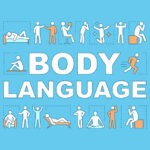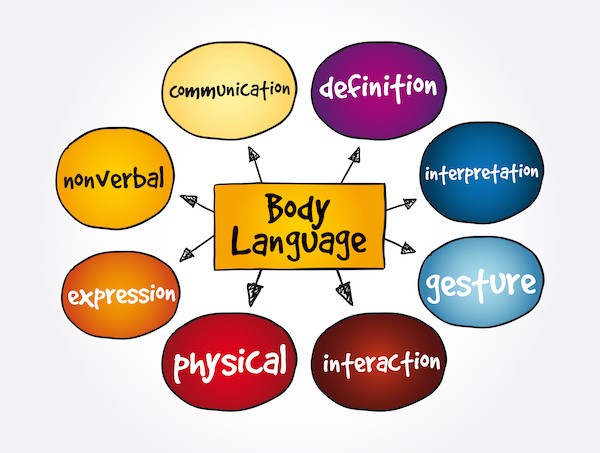
Certified Resume Writer, Career Coach, and Business Owner
In a world where words and phrases rule daily communication, you may wonder why non-verbal communication is important. Whether you realize it or not, you communicate more with nonverbal actions than you do with verbal communication. When you interact with your peers, people are reading your body language, facial expressions, voice, and many other factors that help fill in blanks that words can’t fill.
Even more, when you interview for jobs and interact with your colleagues, your nonverbal communication will be what recruiters and peers remember the most about you. So, here’s how you can maximize your nonverbal communication to enhance your chances of memorable interactions with recruiters, coworkers, and bosses.
What is Non-Verbal Communication?
Before diving into why non-verbal communication is important, you should get a good grasp of what it is. Non-verbal communication is a way of conveying information and emotions without using words. These actions are typically performed instinctually and without conscious thought.

Whether you’re aware of them or not, these physical mannerisms and behaviors send messages to the people around you. If they align with your words, they will build trust and put others at ease. If they don’t, these nonverbal signals will undermine what you’re saying and confuse or upset your audience.
What are the Main Principles of Nonverbal Communication?
Since the pandemic, non-verbal communication has become more important than ever. Virtual communication via Zoom and other online programs became more prevalent and changed the way we naturally interacted with others. Since our view of the other person is limited to their upper body (and a computer screen), the ability to read nonverbal cues (and for them to read ours!) is impacted.
It’s advised to keep several principles in mind as you adjust to this new method of communicating with others. These same suggestions also apply when you’re talking to someone in person.
- Context matters. Pay attention to what’s happening around you and the other individual. For example, is it possible they’re distracted because their young child is playing at their feet while you meet on Zoom and not because they’re disinterested in what you’re saying? Notice the circumstances and timing of your conversation so you can place their body language into the proper context.
- Culture, gender, age, and location matter too. Nonverbal behaviors can have different meanings in various cultures and geographic locations. Someone’s age and gender can also influence how they interpret these signals. So take note if you’re conversing with someone older or younger than you, of the opposite gender, from another state or country, or of a different ethnicity. These factors all affect nonverbal communication.
- Incongruence can mean different things. Our instinct is to assume someone is lying if their body language doesn’t match what they are saying. But it’s essential to remember that there can be other reasons for a misalignment (see principles 1 and 2 above, for example). Keep this in mind before you automatically jump to incorrect conclusions.
- Nonverbal signals don’t always match. Some people are better at lying than others, but even proficient liars have trouble controlling all aspects of their body language. They might match most of their nonverbal behaviors to their words, but inevitably one or two won’t seem right. For example, they might avoid eye contact, smirk, or excessively fidget. These signals can tip you off to the fact that they aren’t being truthful.
- Intuition is usually right. They always say to trust your gut. This is 100% valid when it comes to nonverbal communication. Heed your instincts. You’ll likely know innately if someone else is being genuine or not based on their body language.
Importance of Nonverbal Communication
Your nonverbal cues should match what you’re saying. Why? Because if they don’t, you might offend or confuse the other person. They might even find you to be deceitful. Conversely, if your body language supports your words, you’ll come across as authentic, trustworthy, and attentive.
Let’s discuss the impact nonverbal signals can have in a conversation. Listed below are several of the roles body language can play in an interaction:
- Complementing: A gesture, for instance, can increase the impact of your verbal message. Say you pat someone’s hand as you console them; this touch would likely convey your message more powerfully than just words alone.
- Repetition: Your body language supports and strengthens the message you’re trying to express.
- Accenting: Nonverbal signals can add emphasis to a verbal message. For example, if your boss hits the table while yelling at you, you’ll take special note of what he’s trying to tell you!
- Substitution: People sometimes communicate nonverbally instead of verbally. In other words, they might give you a nice, big smile instead of saying, “I’m happy.”
- Contradiction: When someone’s body language doesn’t match what they’re saying, it contradicts their message and causes distrust, tension, and confusion.
Common Types of Non-Verbal Communication
Nonverbal communication can be classified into 10 types. These include facial expressions, gestures, movement, body language, personal space, paralinguistics, eye gaze, appearance, haptics (touch), and artifacts. Continue reading below to learn more about each of these.

- Facial expressions: Think of a smile, frown, or upraised eyebrows. These are facial expressions, and they play a huge role in nonverbal communication. While their meanings can vary culturally, the expressions of fear, happiness, sadness, and anger are globally recognized.
- Gestures: An intentional movement, popular gestures include pointing, waving, handshakes, and giving a thumbs up. They can carry very different meanings culturally. One example is the V sign, which means peace or victory in the U.S. but is an insult in other parts of the world.
- Movement: How you move your body can affect how others see you. Fidgeting, walking quickly or slowly, and sitting or standing all send different messages to those around you.
- Body language: This category includes body posture and arm/leg crossing. During a job interview, for instance, it’s a good idea to maintain a good posture to convey confidence. Crossing your arms and/or legs can indicate that you’re defensive and closed off.
- Personal Space: Proxemics refers to the amount of space we believe we’re entitled to when conversing with someone else. Generally, this falls between 18 inches and four feet but is influenced by culture, personality, familiarity, social norms, and other situational factors.
- Paralinguistics: This refers to vocal sounds that aren’t words. Examples include the tone of your voice, how loud or quickly you speak, and the inflection and pitch of your voice. Think of how you’ll appear to someone else if you speak loudly and forcefully versus softly and timidly.
- Eye gaze: Your eyes convey a lot about your intentions. For example, if you don’t maintain steady eye contact, you may come across as shifty and deceptive. How often you blink and whether you stare are other nonverbal cues people notice.
- Appearance: How you look, dress, and style your hair also influences how others perceive you. Hence, it’s imperative that you dress appropriately for a job interview or first date. Even the colors you choose to wear can impact others emotionally.
- Haptics (touch): You’re probably already aware of how much one can communicate through touch. Compassion, control, comfort, affection, and sympathy can all be expressed in this way.
- Artifacts: A powerful form of nonverbal communication, artifacts are images and objects that act as communication devices. Examples include avatars, uniforms and clothing, jewelry, and other accessories.
How to Point Out Nonverbal Communication in Personal Interactions
Learning to identify and decipher nonverbal cues is a valuable skill to develop. It will help you understand how others feel, their intentions, and how you should approach them. Moreover, this will make it easier for you to determine if someone is being dishonest.
Recognizing nonverbal signals takes practice, but you can master it by focusing on three factors:
- Posture: Slouching might indicate disinterest, anger, or anxiousness. A straight spine usually means someone is engaged, attentive, and open to your ideas.
- Facial expressions: Frowns, tight lips, and furrowed eyebrows usually convey anger, frustration, and confusion. Smiles and relaxed facial muscles generally mean the opposite.
- Arms and legs: Crossed arms or legs can mean that the person is closed off or feeling negative.
Cultural Differences May Change Nonverbal Scenario
Cultural differences in organizations exist more now than they have in the past. Maybe your organization is international, or maybe your company is looking to improve workplace diversity. Either way, it’s crucial to understand that gestures and nonverbal cues mean different things to different people.
For example, giving someone a thumbs up in America is a positive nonverbal gesture. Meanwhile, giving the thumbs-up to someone in Iran or Afghanistan is the equivalent of an American sticking their middle finger up at someone else. Cultural context even dictates the meaning of displays of emotion, such as eye contact and facial expressions. In some countries, excessive public displays of emotion are frowned upon, and direct eye contact is supposed to be avoided; in others, these behaviors are fine.
How to Improve Nonverbal Communication?
Without a doubt, improving your nonverbal communication is always an advantage. Surprisingly, improving nonverbal cues all starts with awareness. In your next interaction, try to assess yourself based on this checklist:
- What was your posture like?
- Did you often cross, fold, or fidget with your arms and legs?
- Were you fully present in the moment, or were you gazing off?
- How well did you manage your stress or anxiety?
- Did you maintain neutral or positive facial expressions?
You may find that you are better in some areas than others. If you’re not very self-aware, then it doesn’t hurt to ask someone what it’s like interacting with you. From there, you can get a good idea of what needs improvement.

Advantages of Nonverbal Communication
Many advantages come from having a deep understanding of nonverbal communication:
- If you can read nonverbal signals, you don’t need to hear the verbal message.
- Nonverbal communication gives clarity and reinforces what’s being said.
- Nonverbal cues benefit people who can’t read and those who can’t hear or speak.
- Nonverbal messages can be more emotionally impactful than verbal ones.
- Nonverbal communication is generally more simple and quicker than the alternative.
Disadvantages of Nonverbal Communication
But let’s not forget that there are some disadvantages to relying on body language alone to understand what’s going on:
- Gestures, facial expressions, and other nonverbal signals can be misconstrued.
- Nonverbal communication is less precise than verbal communication.
- Nonverbal behaviors can be interpreted differently across cultures.
- Nonverbal messages are short; they don’t translate into long conversations.
- Nonverbal communication can be confusing and can distort information.
Perfect Example of Understanding Nonverbal Communication
How can you implement all you’ve learned about nonverbal communication in this article? Consider an example of Mary, a recent college graduate who is trying to land a job.
Mary goes on her first job interview. Before arriving, she picks out a professional business suit to wear and styles her hair, so it’s neat and out of her face. When she greets her interviewer, she smiles and firmly shakes his hand. Throughout the interview, she sits straight, keeps her arms and legs uncrossed, and doesn’t fidget. She keeps her voice steady, speaks clearly, and maintains good eye contact. The interviewer, impressed by her confidence and assertive communication style, offers her the job.
Bottom Line
Nonverbal communication doesn’t always get the attention it deserves. But by understanding why non-verbal communication is imporant and learning how to become aware of it, we can improve our ability to communicate effectively – both professionally and personally.






